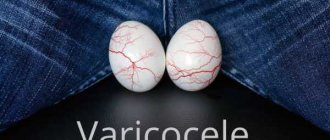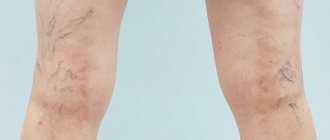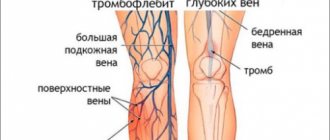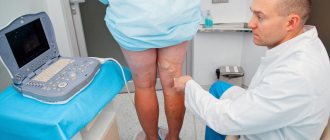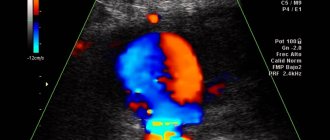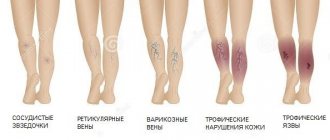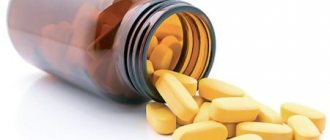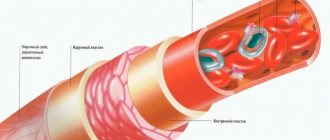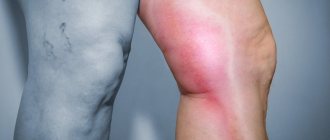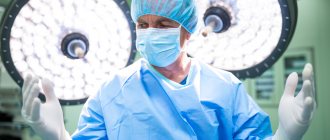July 27, 2020
Varicose veins are dilation of the superficial veins of the lower extremities, accompanied by valve incompetence and impaired blood flow.
Varicose veins are dilation of the superficial veins of the lower extremities, accompanied by valve incompetence and impaired blood flow. The term “ varicose veins ” comes from Lat. varix - “swelling”. This diagnosis is very widespread: up to 89% of women and up to 66% of men living in developed countries have signs of varicose veins to one degree or another.
Most often, the valves that are subject to maximum mechanical stress are the first to be affected. In this case, pathological discharge of blood occurs through the mouth of the great and small saphenous veins, sometimes through large perforating veins. Excessive blood volume arising in the superficial veins gradually leads to overstretching of the venous wall. The total volume of blood contained in the superficial venous bed of the lower extremities increases, resulting in dilatation and valvular insufficiency in the perforating veins. Varicose veins most often affect the veins of the lower extremities, but can occur in any organ or part of the body.
Varicose veins of the lower extremities. Causes of the disease (Wikipedia and the official approach):
There are primary and secondary varicose veins of the lower extremities. Secondary develops as a result of injuries, tumors, etc., when the venous system cannot fully perform its functions.
Occupations in which varicose veins most often develop
Primary develops due to weakness of the venous wall. Reasons that contribute to the development of varicose veins of the lower extremities:
- pregnancy;
- hormonal imbalance;
- heavy static loads;
- smoking;
- work that requires standing for long periods of time (for example, hairdressers, salespeople, waiters);
- sitting in an incorrect position, especially crossing your legs;
- high-heeled shoes;
- sedentary lifestyle.
All these factors contribute to a deterioration in the outflow of blood from the lower extremities, thereby the superficial veins become overfilled, dilate, and blood stagnation occurs. Heredity plays an important role in the development of the disease.
Varicose veins of the lower extremities - symptoms
Varicose veins of the lower extremities are accompanied by the following symptoms:
- swelling of the legs at the end of the working day;
- feeling of heaviness in the legs;
- cramps in the calf muscles, mainly at night;
- pain, burning sensation in the legs;
- spider veins on the legs;
- formation of trophic ulcers.
Spider veins are small red-blue nodules on the skin that can be seen on the legs at the very beginning of the disease. Often, varicose veins of the lower extremities during pregnancy cause particular discomfort.
It was
With varicose veins, the veins dilate, the valves in them move apart and can no longer hold blood - instead of actively moving towards the heart, it stagnates in the dilated veins, and with tension and coughing it even tends down to the foot.
This leads to swelling, skin pigmentation and trophic ulcers. Varicose veins are scary not so much in themselves as because of their complications. Among them are thrombosis, thrombophlebitis (inflammation of blood clots) and even pulmonary embolism - this is the detachment of a blood clot and blockage of the blood vessels of the lungs. The latter condition is often fatal if a large vessel is blocked. For a long time, the main method of treating varicose veins was surgical removal of veins damaged by the disease. This operation is traumatic, accompanied by blood loss, scars remain after it, it takes 1.5-2 weeks to recover in the hospital, and then you need rehabilitation at home. It is done under general anesthesia or so-called spinal anesthesia. Unfortunately, this is how varicose veins continue to be treated in most medical institutions today.
Varicose veins of the lower extremities - stages
There are several stages of disease development:
- compensation – spider veins and tortuous veins appear on the legs, no complaints
- subcompensation – there are complaints of swelling, cramps of the calf muscles, a feeling of heaviness, fatigue in the legs, pronounced dilated veins are visually determined
- decompensation – dermatitis, minor hemorrhages are added, the skin becomes dense, dry, easily wounded, pigment spots appear
The earlier the disease is detected, the easier it is to treat.
Varicose veins of the lower extremities - diagnosis
To accurately diagnose the disease, you must consult a doctor. Vascular surgery deals with varicose veins of the lower extremities. To make a diagnosis, in addition to complaints and visual examination, it is necessary to use special research methods.
Ultrasound diagnosis of varicose veins of the lower extremities
Duplex angioscanning is considered the gold standard. This method combines ultrasound and Doppler scanning. Thus, it is possible to see the condition of the vascular wall in real time and assess the speed of blood flow in the venous system of the lower extremities.
Laser treatment of varicose veins - “The gold standard for the treatment of varicose veins in Moscow”
Now it’s no secret that the Endovasal Laser Coagulation (EVLC) procedure has become a common everyday procedure for most phlebologists in our country. The excellent results of treatment with this technique equate it to the “Gold Standard”. It would seem that all possibilities and innovations in this direction have already been exhausted and the patient does not need to think about where to turn for help - everything will be done the same everywhere.
However, it is not!
Laser generator with new wavelength 1940 Nm
Varicose veins of the lower extremities - complications
If there are varicose veins of the lower extremities, treatment should begin faster, otherwise the disease will progress, which is fraught with serious complications. Stagnation of blood in the veins contributes to the formation of blood clots, phlebothrombosis develops, and if the vein also becomes inflamed, thrombophlebitis develops.
Acute thrombophlebitis of superficial veins
The resulting blood clots can break free from their place at any time and enter the bloodstream. In this case, the blood clot enters the veins of the lungs, blocking them. In this case, a person can die from suffocation even before the ambulance arrives, because such a formidable complication is extremely difficult to treat even in a specialized hospital, and there is very little time to save a life.
In addition, due to blood stagnation, nutrition of the lower extremities is disrupted. Deep trophic ulcers form on the skin, which heal poorly and tend to spread. This can lead to amputation of the limb.
Based on the fact that complications of varicose veins of the lower extremities are not at all harmless, it is necessary to contact a qualified specialist as soon as possible. Only a doctor can prescribe effective treatment and help avoid complications.
So, combined phlebectomy, as a rule, consists of three stages:
- Estuary ligation of the trunk of the great or small saphenous vein (ligation of perforating veins) in order to eliminate pathological reflux of blood from deep veins to superficial ones
- Removal of the main trunks of the saphenous veins
- Removal of varicose veins
In this way, surgeons normalize blood circulation in the limb, but at the same time preserve unchanged venous areas.
Among the characteristic disadvantages of traditional phlebectomy are a fairly large number of contraindications to its implementation. Since the operation itself is invasive, it has a high operational and anesthetic risk. If the patient has concomitant pathologies of moderate to severe severity, the surgeon will not take risks and perform surgery.
In addition, combined phlebectomy is characterized by a rather difficult rehabilitation and recovery process - compared to minimally invasive interventions. On average, a patient spends about a week in the hospital after surgery.
Since phlebectomy involves making cuts into the patient's biological tissue, it should be understood that the surgeon will apply sutures. Modern suture material allows cosmetic stitches to be applied, but certain marks on the skin will still remain.
Possible complications of combined phlebectomy include:
- Bleeding during or after surgery
- Purulent processes in the wound area
- Wound infection, development of inflammation
- Hemorrhages
- Hematomas
- Development of lymphocele
The development of these complications, as a rule, is associated with two factors: firstly, with the high traumatic nature of the operation, and secondly, with a violation of the technique of its implementation.
Varicose veins of the lower extremities - how to treat with ointments
In the pharmacy you can find a huge number of ointments for varicose veins of the lower extremities. They are based on substances that improve tissue trophism, relieve swelling and strengthen the vascular wall. Varicose veins of the lower extremities, photos and reviews of ointments are available on the drug pages on the Internet.
Treatment of varicose veins with ointments and gels
In the early stages of the development of the disease, the use of various ointments can improve the condition of the venous system and slow down the progression of the disease, but it will not be possible to completely defeat varicose veins of the lower extremities. The results will be available only after visiting a doctor.
Endovenous laser obliteration
Unlike phlebectomy, endovenous laser obliteration (EVLO) does not require incisions of biological tissue. But, at the same time, this innovative method is almost as effective as traditional surgical intervention . In fact, the role of a scalpel when performing EVLO is performed by a laser, which, thanks to its thermal radiation, “seals” the vein from the inside. But first things first.
Initially, the method of eliminating varicose veins using a laser became widespread in the West - in Europe and the USA.
Among the first Russian specialists who published in research papers the advantages of using lasers in phlebology was the scientific director of the ANTIREFLUX Center, Doctor of Medical Sciences K. V. Mazaishvili. Thus, in 2010, the manual “LASER SURGERY FOR VARICOSE DISEASE” was published, edited by Konstantin Vitalievich.
Today, at the ANTIREFLUX Center, advanced training courses for doctors are being conducted in the specialization “Endovenous laser obliteration”. Hundreds of surgeons from all over the country come to our specialists to learn their skills and craftsmanship. The high qualifications of ANTIREFLUX doctors leave no doubt. This is confirmed by the huge number of grateful reviews from patients cured of varicose veins.
In short, the essence of EVLO is as follows: the surgeon gradually introduces a laser into the lumen of a vessel affected by varicose veins - and, passing the LED along the vein, achieves its complete obliteration (closing the lumen).
Under the influence of thermal radiation from the laser, microscopic vapor bubbles are formed in the blood of the vessel. The blood comes into contact with the endothelium of the vein, destroying its protein. Due to damage to the vascular walls, they stick together. Thus, the walls of the vein are “welded”, and complete occlusion of the lumen of the varicose vessel occurs.
After the procedure is completed, a compression stocking is placed on the patient’s leg, and he can immediately get up from the couch.
Varicose veins of the lower extremities - treatment: surgery or still a procedure?
- Intravascular coagulation. Do you have varicose veins of the lower extremities? Laser treatment in Moscow is a small endovascular operation during which a vein is obliterated with a laser. Varicose veins of the lower extremities will be removed; laser treatment is based on the introduction of blood flow into the desired vein. This is how varicose veins of the lower extremities are defeated. Laser treatment, the cost of which is not so high, takes little time and is well tolerated by patients, and they forget that they had varicose veins of the lower extremities; laser treatment (the price in our center is affordable) is very effective. The final figure depends on the stage of the disease and the amount of work the doctor does. Do not be afraid that varicose veins of the lower extremities will attack again later. Laser treatment (there are quite a lot of reviews!) will definitely put you “on your feet”!
- Short stripping is a minimally invasive technique in which a small section of the affected main vein is removed. In this way, it is possible to preserve as many healthy sections of veins as possible.
- Cryophlebectomy – removal of a vein using a cryoprobe. The operation is low-traumatic - however, one small incision is made to insert the probe. After the operation, you see results immediately.
Why is it better to treat varicose veins with laser in our MIFC clinic?
We do not want to lag behind the most advanced European technologies and try to be “at the cutting edge” of phlebological care. Therefore, our medical center began to use this laser device for the FIRST time in Russia. And the thousands of years of experience in laser interventions accumulated over many years allowed us to safely perform laser procedures on a new generator with a wavelength of 1940 Nm.
Laser treatment without surgery - new possibilities!
It is also worth noting that despite the need to purchase new expensive equipment for these procedures, we DO NOT RAISE the prices for our services.
In order to learn all the intricacies of working with the new device, we held negotiations with leading European phlebologists from Germany and Latvia who use this laser.
At a master class on laser treatment of varicose veins in Riga with Dr. Uldis Maurins
Our specialists first completed a training cycle with a master class at the Clinic of Dr. Maurins, the president of the Baltic Society of Phlebologists and a recognized leader in the treatment of varicose veins.
We are confident that only the use of the best methods and the constant improvement of our doctors from recognized world leaders will allow us to achieve the highest results in the treatment of varicose veins.
Now the patient has a choice!!! Be treated using established methods or using the latest, more effective technologies. We don't insist - we offer!!!
Varicose veins of the lower extremities - treatment with radiofrequency
How to remove varicose veins of the lower extremities? RFA treatment is of particular interest to patients. Why do many people dream of eliminating varicose veins of the lower extremities and prefer RFO treatment?
Radiofrequency ablation (RFA) is an operation that can be performed on an outpatient basis if you want to forget varicose veins of the lower extremities. RFA treatment in Moscow uses radio frequency, which is used to “seal” a vein and remove varicose veins of the lower extremities. RFO treatment in Moscow is fast and effective.
What is conservative therapy for varicose veins?
Conservative therapy is considered the most accessible form of treatment for problems with venous vessels. Basically, these are self-treatment options that patients can carry out without close medical supervision, even at home. There is an opinion that patients whose varicose veins have minimal manifestations can solve their problems with only conservative therapy instead of invasive treatment methods.
To properly understand the issue of conservative treatment of venous pathology, it is necessary to more accurately determine the methods and practice of conservative treatment of varicose veins.
What conservative methods of treating varicose veins can modern medicine offer?
- Venotonic drugs.
- Ointment forms of medicines.
- Pressotherapy – pneumatic compression.
- Compression jersey.
- Changes in lifestyle, daily physical activity and diet.
Drug treatment using conservative therapy with venotonic drugs. Most often, these drugs are used in tablet form, less often in the form of a suspension. The most well-known preparations are diosmin (Detralex, Phlebodia), as well as their analogues. This is not to say that these drugs are not effective. However, their therapeutic effect for varicose veins is purely symptomatic. It is more appropriate to consider the true effectiveness of drug therapy in combination with radical measures. It is worth clearly understanding that the problem of varicose veins cannot be solved with pharmacology alone.
Caution - varicose veins of the lower extremities
Treatment with traditional methods (prices for herbs and creams differ), but still do not place too much hope on a green pharmacy.
Excess weight provokes the development of varicose veins
It is important to pay attention to nutrition if you have varicose veins of the lower extremities, treatment with traditional methods, the price of which is pennies. It is necessary to limit the consumption of meat, spicy, salty and smoked foods, increase the amount of vegetables and fruits in the diet and eliminate alcohol and coffee.
An optimal daily routine and therapeutic exercises will help improve blood circulation in the extremities. This will take 10-15 minutes a day.
Simple traditional methods of treatment can complement the complex of measures for the treatment of varicose veins. Rubbing the feet with horse chestnut tincture, apple cider vinegar, butter with garlic and many other remedies have been known since ancient times. They will ease varicose veins of the lower extremities, the cost, photos and results can be viewed on our website on the Internet.
Microfoam sclerotherapy
Another minimally invasive method that I would like to talk about is echo-controlled microfoam sclerotherapy . This intervention is considered the most “gentle”: obliteration of the lumen of the vein affected by varicose veins is achieved by introducing microfoam sclerosant into the vein.
Under the control of an ultrasound sensor, the phlebologist punctures the vein at the site of its varicose dilatation and injects sclerosant converted into microfoam (different clinics use sclerosant of varying concentrations - however, it is microfoam that allows you to most quickly achieve the obliterating effect).
The introduction of sclerosant stops after the foam “reaches” the anastomosis of the vessel (the process of foam moving through the vessel is clearly visible on the ultrasound monitor). Then the surgeon performs manual manipulation (massage of the limb) in order to speed up the reaction of the sclerosant with the vein endothelium. The massage is performed along the projection of the vein.
Next, an elastic compression is put on the patient’s leg for a period of 3 to 5 days (the mode of wearing the compression is determined individually). Immediately after the procedure, the doctor asks the patient to walk for forty minutes to rid the deep veins of the remnants of the sclerosing substance.
Characteristics and benefits of sclerotherapy:
- Despite the paradoxically low morbidity and simplicity of implementation, microfoam sclerotherapy can be considered a surgical procedure. At least, the effect of its implementation is often quite comparable even with radical surgical interventions - while the patient actually does not have to go to the hospital or subject himself to general anesthesia. In addition, the person does not experience any pain or fear, which is usually associated with traditional “scalpel” surgery.
- After sclerobliteration, there are no scars left on the patient’s skin. The high cosmetic effect is also an important advantage of this procedure – especially for young women.
- Sclerotherapy has a minimum of contraindications, as well as an extremely low risk of side effects - which makes it possible to perform this procedure for elderly patients, as well as people with severe concomitant pathologies for whom traditional phlebectomy is contraindicated.
- Despite the fact that sclerotherapy is considered an innovative method for treating varicose veins, its cost is perhaps the lowest in relation to other types of minimally invasive interventions. Thus, the most affordable case of treating varicose veins with sclerotherapy cost our patient only 3 thousand rubles.
One of the few contraindications to sclerotherapy is a vein diameter greater than 10 mm. In the context of this fact, we once again draw your attention to the importance of timely consultation with a doctor : varicose veins usually expand gradually - so it is not so difficult to capture the moment “up to 10 mm”.
Varicose veins of the lower extremities - prevention
For prevention, it is necessary first of all to adhere to the work regime. You cannot constantly be on your feet or sit in one position. From time to time it is worth taking short breaks to give your legs a rest.
After a hard day at work, you can massage your feet, after which it is advisable to put your feet on a raised platform. This improves blood flow from the extremities.
Exercises to improve venous blood flow in the legs
Don't get carried away with hot baths and saunas. To prevent varicose veins, it is much more useful to take a contrast shower and rinse your legs with cool water.
It is important to monitor your weight. Excess body weight increases the load on the venous system and contributes to the development of the disease.
If there is a predisposition to developing the disease, and it is not possible to eliminate all risk factors, it is better to engage in prevention. Even if the disease has already begun, do not despair. Varicose veins of the lower extremities are not a death sentence. By detecting the problem in a timely manner and contacting specialists, you can get rid of the disease and avoid serious complications.
We invite you to visit our specialist phlebologist and get rid of varicose veins in the early stages.
Who should use conservative therapy for vein problems?
Conservative treatment of veins is a good option for those who are showing the first signs of varicose veins, and vein problems do not yet require radical treatment. This is also an excellent option for those who are at risk for varicose veins and need prevention. Conservative therapy is also considered the best option for the prevention and treatment of varicose veins for pregnant women or patients for whom radical treatment is not possible for a number of reasons. In the case of pregnant women, conservative therapy for varicose veins is always temporary.
The main thing is that conservative therapy always only complements radical treatment, or is temporary. The replacement of radical measures with conservative therapy no longer meets modern standards for the treatment of varicose veins. Doctors who prescribe only pills, ointments and stockings to a patient with varicose veins doom the latter to long-term, continuous treatment without lasting results, guaranteed to cause complications over time.
Frequently asked questions from our patients on the Internet about varicose veins of the lower extremities
Are varicose veins of the lower extremities dangerous during pregnancy? Anastasia from Belgorod is interested in:
Dear Anastasia! Varicose veins of the lower extremities during pregnancy carry certain risks of developing thromboembolic complications. Therefore, it is necessary to contact a phlebologist and follow his recommendations.
I have had varicose veins of the lower extremities for quite a long time, what surgery is best? Tamara from Ufa asks:
Dear Tamara! If you have varicose veins of the lower extremities, modern minimally invasive surgery will be optimal. The best methods today are thermoobliteration techniques (laser and radio frequency).
I was diagnosed with varicose veins of the lower extremities, how is the operation performed? Boris from St. Petersburg is interested in:
Dear Boris! You have been diagnosed with varicose veins of the lower extremities, and therefore surgery is indicated. In Russia there is no uniform approach to the choice of surgical treatment. There is a classic and outdated phlebectomy technique, with incisions and anesthesia. This operation is usually performed in public hospitals. In specialized phlebological centers, innovative techniques are used through puncture approaches (punctures). Such operations are performed on an outpatient basis, under local anesthesia, without incisions or pain.
Varicose veins of the lower extremities, what is it? Elena from Pskov is interested in:
Dear Elena! Varicose veins of the lower extremities are a chronic progressive disease, manifested by pathological dilation of venous vessels, disruption of the normal functioning of vein valves, which adversely affects blood flow. This condition often develops in people whose work and lifestyle are associated with prolonged static load.
Varicose veins of the lower extremities, what treatment is used? Natalya from Petrozavodsk is interested in:
Dear Natalia! When a diagnosis is made: varicose veins of the lower extremities, a fairly varied treatment is used. The conservative approach has many supporters, both among patients and doctors. But we must immediately clarify that treatment of varicose veins of the lower extremities cannot only be conservative. Modern treatment of varicose veins involves the use of innovative techniques that radically eliminate the pathology. You can see reviews from patients of our clinic on our website:
Opportunities of the Innovative Vascular Center
- Thermal methods for treating varicose veins are endovenous laser coagulation (EVLC) and radiofrequency obliteration (RFO) of the veins of the lower extremities.
Endovenous laser coagulation is an effective treatment for varicose veins, the principle of which is based on the thermal effect of laser energy. This treatment was introduced in 2001 and is still the best method. With laser coagulation, the damaged vein is heated by a laser beam, which provides a strong effect of damaging the collagen of the venous wall, causing an inflammatory process in the vein and its overgrowth. Advanced varicose veins on the legs, which are treated with this method, regress completely and without a trace, and its main symptoms disappear: swelling, heaviness in the legs, hyperpigmentation of the skin. Varicose veins have been treated at the Innovative Vascular Center in Moscow using lasers since 2005, since the advent of this technology in Russia.
EVLT begins with the installation of a laser fiber into the lumen of a varicose vessel through a skin puncture, which is guided along the affected vein to the site of the incompetent valve. For the patient, this method is a safe, painless and reliable way to prevent further development of the disease and its complications. Complete elimination of varicose veins is observed in 98% of patients with proper use of the EVLT method. The capabilities of this method make it possible to both treat varicose veins on the legs in women and correct venous outflow in case of trophic ulcers.
Radiofrequency obliteration (RFO)
Treatment of varicose veins using the radiofrequency obliteration (RFO) method is a similar thermal method, but heating of the tissue of the venous wall occurs according to different physical principles due to radio wave energy. Radiofrequency obliteration allows you to remove varicose veins and eliminate its symptoms; such treatment in its immediate and long-term results does not differ from EVLT, but is more painstaking for a phlebologist.
Other thermal methods
When deciding how to treat varicose veins, phlebologists often used exotic methods. Varicose veins were treated with thermal effects using superheated steam and bipolar electrocoagulation. However, modern thermal methods are more effective and they allow the doctor to prevent further development of varicose veins, and the patient to be treated on an outpatient basis without disturbing his lifestyle. In the hands of a novice phlebologist, thermal ablation methods can cause unpleasant complications: decreased sensitivity, burns, seals. The effectiveness of this method in the hands of an experienced phlebologist is more than 98%, and the laser method and RFO make it possible to get rid of not only the initial form but also severely pronounced varicose veins on the legs without incisions. In the photographs from the “Treatment Results” section you can see the view before and after minimally invasive treatment.
Non-thermal methods for eliminating stem reflux
For many years, phlebologists have been thinking about how to cure varicose veins of the lower extremities without incisions and pain. The disappearance of the saphenous veins in the arms after frequent injections prompted the idea that certain substances can cause inflammation of the vein walls - thrombophlebitis and subsequent gluing of them with the disappearance of the lumen of the vein. After the advent of the Fegan method, when treatment began to be carried out based on the cause of varicose veins, the development of non-thermal scleroobliteration methods began. Since then, varicose veins on the legs, especially in women, are treated not only with a scalpel, but also with a syringe.
- Sclerotherapy
Sclerotherapy appeared in the practice of doctors at the end of the 19th century. In recent years, the method of treating varicose veins using injections of a special substance (sclerosant) has reached perfection. The main point of sclerotherapy is to inject a drug into a varicose vein, which causes inflammation and subsequent gluing of the varicose vein. Sclerotherapy does not involve eliminating the cause of venous insufficiency and is more suitable for certain forms of varicose veins or in the initial stages of the disease. Advanced varicose veins of the lower extremities are treated with more complex methods; damage to the trunk of the great or small saphenous vein does not allow one to count on a long-term effect of sclerotherapy, since a relapse is sure to occur due to reflux.
Sclerotherapy can be done if you are not allergic to tetradecyl sulfate or polidocanol. These substances are the main sclerosants. During sclerosing treatment, manifestations of thrombophlebitis may occur, especially if liquid forms of the drug are used. Sclerotherapy of perforating veins is highly effective in the treatment of venous trophic ulcers. It is possible to eliminate the manifestations of varicose veins of the lower extremities at any stage with the help of sclerotherapy, but the relapse rate is about 40% over the next 5 years.
The advantage of sclerotherapy is a good immediate effect and low cost of treatment. Injections of sclerosant lead to the gluing of veins and the cessation of the pathological process - reflux of blood through the saphenous veins. The drug is usually injected in the form of foam (Foam-Form) into varicose veins. A spasm of dilated subcutaneous vessels is formed, prolonged contact of the foam form of sclerosant with the vein wall and their subsequent inflammation and gluing. This process occurs unevenly and the degree of obliteration of the vein is not the same, so 40% of patients after sclerotherapy have relapses of varicose veins. After sclerotherapy, the affected area of the veins of the lower extremities closes and over time completely heals, and the blood flow in the opposite direction stops. To prevent the occurrence of skin necrosis due to the penetration of the foam form of sclerosant into the subcutaneous tissue, administration is carried out strictly under ultrasound control.
Foam sclerotherapy can be used as a stand-alone method or in combination with laser treatment to eliminate varicose veins. The number of sessions to eliminate varicose veins using sclerotherapy depends on the stage of varicose veins and the condition of the veins. The course of treatment usually consists of 2-3 procedures. The area of skin over the sclerotic vessel may take on a dark shade for 2-3 months (hyperpigmentation appears). It can ruin a woman's legs for several months, so this treatment is best done in the winter months. Drug treatment and ultrasound-guided vascular punctures can speed up the process of resorption of intravascular fluid accumulations (coaguls), the risk of which is about 10%. Coaguli form when there is insufficient compression, but will certainly go away over time. Many patients know that within a month after sclerotherapy, the signs of varicose veins of the lower extremities go away for many years, which is why sclerotherapy is still one of the most popular treatment methods.
- Using special glue (VenaSeal)
Since its inception, this method has aroused great interest among phlebologists. It involves gluing the trunk of the great saphenous vein with a special cyanoacrylate glue. In the lumen of the vessel, this glue polymerizes and fills the lumen of the dilated vessel. According to the developers, this method does not require any anesthesia, and a “plug” appears in the vessel, which reliably blocks blood flow. Taking this into account, half an hour is enough for the procedure to eliminate varicose veins on the legs. Venasil is the only technology for the treatment of varicose veins that does not require wearing compression stockings.
Most women can return to normal activities immediately. Symptoms of chronic venous insufficiency are relieved shortly after the procedure. The process of active promotion of this glue to the phlebological market should begin in the near future. However, there are certain disadvantages: The presence of a foreign body in the human body. The curdled glue remains in the vessel forever and can cause chronic allergies; sometimes there is inflammation of the vessel wall or rejection of the polymer with suppuration. Acute thrombophlebitis of the glued vessel may occur.
The use of glue in the trunk of the great saphenous vein does not eliminate the need to eliminate varicose tributaries, which is why doctors will have to remove signs of subcutaneous varicose veins with sclerotherapy or miniphlebectomy. The visible effect of using glue appears only when combined with other methods of eliminating varicose veins. The patient has to pay more. The unreasonably high cost of the gluing kit makes this procedure significantly more expensive than the modern laser or radio frequency method.
In our clinic, preference is given to thermal methods. We believe that it is better to give good local anesthesia than to treat varicose veins of the saphenous veins on the legs with an expensive and untested method. Moreover, the result is the same at best. If a relapse occurs, the patient will have to undergo a complex operation to remove the sealed vessel, since other methods will no longer be applicable.
- ClariVein mechano-chemical obliteration technology
The modern method of combined treatment of reflux along the subcutaneous venous trunks adds extra weight to conventional sclerotherapy. Mechano-chemical procedures mean a combination of mechanical damage to the inner surface of the venous wall and the introduction of a sclerosing drug. A catheter is inserted into the main saphenous vein through a puncture under ultrasound guidance. After installing the catheter in the desired location, the device is connected. The rotating sharp head of the catheter makes up to 3.5 thousand revolutions per minute, causing severe damage to the inner layer of the venous wall. At the same time, a sclerosing drug is injected through the catheter, which “mixes” in the lumen of the vessel and, using the rotating part of the catheter, acts on the vascular wall, causing its inflammation and gluing.
To date, the only advantage of this technology is the absence of the need for tumescent anesthesia. Mechano-chemical obliteration should, according to its inventors, trigger a stronger obliteration effect than foam sclerotherapy, although for some reason convincing data have not yet been presented. It is clear that such varicose veins can be treated with other minimally invasive methods, so its advantages are not obvious. The introduction of such therapy in Russia will begin in 2021, but statistical data on its advantages over EVLT and sclerotherapy do not yet exist. We have to wait for further studies from Europe or the USA in order to accurately determine the place of this technology.
- Miniphlebectomy
This is a modern microsurgical aesthetic method for removing varicose veins. It involves a delicate technique of puncturing and pulling out varicose veins using special tools. This operation is not for a novice phlebologist; you need to have the skills of delicate surgery. Miniphlebectomy is an operation without the use of a scalpel and is performed under local anesthesia. The punctures are carried out in the direction of the skin lines, so after 2 months they are practically invisible.
Miniphlebectomy has replaced the classical operation for varicose veins, which involves the use of 1-3 cm incisions, as it is aesthetically flawless, painless and very effective. By assuming how varicose veins manifest, the doctor can clearly plan micro-punctures and get by with minimal intervention. The patient can go home on his own feet immediately after the operation. Miniphlebectomy can be an independent effective method of treating varicose veins, or used in combination after laser coagulation of varicose veins. Removal of varicose veins is carried out using a special technique developed by Professor Varadi. This technique has been perfectly mastered by our phlebologists and allows for the removal of varicose veins on the legs - an effective treatment regardless of its cause.
